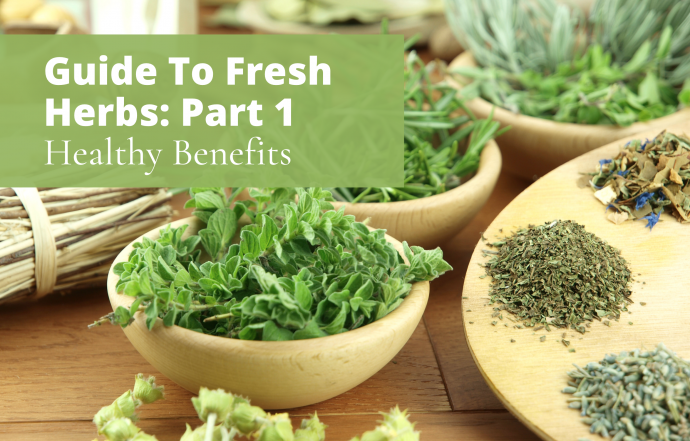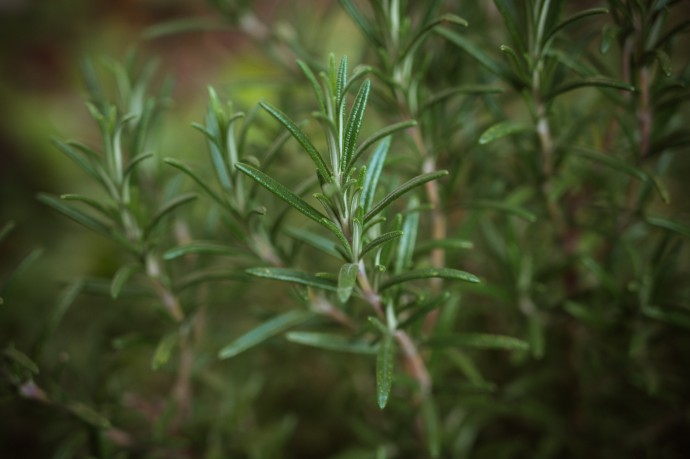Hope you liked this little guide. Next time I will tell you about less common herbs that are pretty awesome, and share some ideas of how to prep and store the fresh herbs.
Do you grow herbs at home? What are your favorite? Tell me, let’s discuss in comments!
Herbs can magically flavor up dishes without resorting to loads of salt, butter, and cheese. Adding a little green to a meal not only makes it prettier and tastier, but can pack some exceptional health benefits, too. Learn how to use the most common fresh herbs, that will give a delicious accent to your favorite dishes!

Rosemary

Used externally, rosemary essential oil can be applied in a diluted form to relieve muscle cramps and arthritic joint pain. It also has a reputation for preventing allergies, improving memory and concentration, boosting the immune system.
Rich source of antioxidants, iron, zinc, calcium, and vitamin B6.
Rosemary complements similarly strong flavors such as wine and garlic; starchy foods (bread, scones, potatoes); rich meats such as lamb, pork, duck and game; vegetables such as eggplants, zucchini; and is also used in sausages, soups and stews, or steeped in olive oil to flavor them. Use them finely chopped.
Coriander

My favorite herb! For more than three millennia, coriander has been cultivated for its aromatic foliage, roots and seeds, all found in the tombs of the pharaohs. The pungent leaves and stalks are popular in Southern Asian, Middle Eastern, South American and Mexican cooking, in salads, soups, legume dishes, curries and stir fries. Long cooking destroys the flavor of the leaves, so add them just before serving. Roast the seeds to enhance their flavor.
Reduces skin inflammation, helps to lower cholesterol level, reduces allergic reactions.
Rich source of iron, calcium, essential oils and
vitamin C.
Coriander is a common ingredient in spice rubs, marinades, chilis, sauces, soups, curries, chicken dishes, potato gratins.
Lavender

French lavender is frequently included in the herb blend herbes de provence, which benefits from the subtle floral flavor. As a rule, lavender can be used similarly to fresh rosemary, in recipes like meat marinades and baked breads. Lavender flowers also make a beautiful garnish for salads, desserts, and more.
Relieves stress, promotes restful sleep, prevents infections, reduces inflammation.
Lavender is high in antioxidants, vitamins A and E.
Basil

Basil is one of the great culinary herbs. Different varieties are used extensively in both European and Asian cooking. Basil can be consumed in larger quantities than some of the stronger flavoured herbs and therefore may be of a higher nutritional value.
Basil has high anticancer potential, and treats headaches, lowers blood sugar level.
Basil is an excellent source of iron, calcium, potassium and Vitamin C, all of which are hugely beneficial to one's health. It also contains smaller amounts of Vitamin A, magnesium and manganese.
Pick up a bunch of this fragrant herb while it's in season. And don't worry about how you'll manage to use it all—there are just so many delicious ways.
Go the traditional route and whip up a mean pesto sauce. Use as a condiment or as a sauce for fish or pasta dishes. Infuse your favorite olive oil with basil. It only takes a few minutes! Whip up a batch of a summer veggie soup--add ribbons of chopped basil for more seasonal flair. Toss whole basil leaves on your favorite pizza when it's hot out of the oven. Delicious! In cooked dishes, basil quickly loses its aroma and the leaves tend to darken, so add it to give depth of flavor during cooking and then, for fragrance and visual appeal, stir in a little more just before serving.
Arugula

In the culinary world arugula is used as a herb, a salad green and even a leaf vegetable, making it a versatile ingredient in the kitchen. It can be used both raw and cooked, though cooking will give the leaves a milder flavor.
Reduces the risk of cancer, improves eyesight, and strengthens the brain.
Rich in calcium, phosphorus, magnesium, sodium, vitamins A, C, E, and folic acid.
Add to raw pesto and sauces to showcase its pungency. Use as a leafy bed for grilled seafood. Chop and sprinkle atop pizza and pasta just before serving. Combine with other greens to spice up a salad. Add whole leaves to grilled cheese sandwiches.
Sakura Cherry Blossoms

Sakura is getting more and more appreciated and not just because of its beauty. The Sakura flowers have a very subtle, flowery flavor. Combining sublime appearance and taste, Sakura is a great ingredient both for flavoring and decoration.
Improves the immune system, lowers blood pressure, and protects skin natural barriers and vision.
Rich in antioxidants and omega-3 fatty acids.
Use it to beautify cookies and pastries, simply cook it with rice, or use it to cook traditional Japanese mochi or any salad.
Sage

Sage helps to improve brain function, reduces inflammation, strengthens bones and prevents diabetes. Rich in vitamins K and B6, manganese, calcium, iron. Sage is a herb with several promising health benefits.
It's high in antioxidants and may help support oral health, aid brain function and lower blood sugar and cholesterol levels. This green spice is also easy to add to almost any savory dish. It can be enjoyed fresh, dried or as a tea.
Whether you use fresh or dried sage will determine when the herb should be added to the recipe. Sage is often paired with other herbs such as thyme, marjoram, and rosemary and harmonizes well with garlic, onion, oregano, parsley, and bay leaf.
Add to pasta sauces; use for meat or poultry stuffings; quickly fry in butter and use as a garnish for risotto or pumpkin dishes.









Do you have ideas to give me.
Thanks for your advises.
Claudette
As for preserving, I prefer freezing and drying. For immediate freezing: harvest the parts you want to freeze, chop them and pack them into ice cube trays: this is an ideal ‘portion’ which can be used when you have no fresh herbs available. I have a special rack for air drying, but it takes longer. Sometimes I dry them in an oven on a very low heat. I think I'll sum up everything in detail in a separate post soon :)